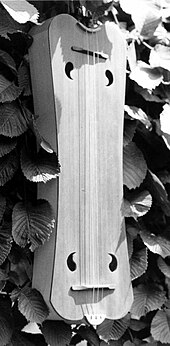Tambourine de Bearn

The Tambourin de Béarn , French and tambourin de Gascogne, tambourin à cordes, German Saitentambourin , rare stringed tambourine , basque TTUn-TTUn is a beaten with a mallet long rectangular box zither , the alternative to a Tabor (Tambourine), primarily for bourdon accompaniment of a one-hand flute (French galoubet ) is used with three finger holes. It can be found in a similar body shape with three to eight strings. The tuning is often kept in root, tonic and dominant or root and fifth. The instrument, which is related to a psaltery , is easy to play because the strings are all struck with a clapper.
Origin and Distribution
Béarn is a southern French region belonging to Occitania on the Spanish border in the French Basque Country . The Basques call the instrument ttun-ttun and play it in the traditional way with the one- handed flute txistu . Together with the drone zither épinette des Vosges in the Vosges, the string tambourine is one of the few traditional folk musical instruments in France.
A corresponding musical instrument is mentioned in sources from the 16th century under the name altobasso for Venice . The rectangular struck drone zither has been documented since the 15th century at the latest, when it appears on a fresco painted by Filippino Lippi in 1489 in the church of Santa Maria sopra Minerva in Rome. Since the 17th century, the struck box zither under the name Tambourin de Béarn has only been an instrument of folk music that found its way into salons in France in the 18th century with the shepherd's fashion .
A similar long rectangular shape has the momentum Zither (English Bell harp ), the mid-18th century to have been invented by English soldiers John Simcock and was used until the late 19th century, especially by English buskers.

literature
- Jordi Ballester: The Stringed Drum and the 16th Certury Music: New Iconographical Sources. In: Anuario Musical, No. 66, 2011, pp. 47–60
- The String Drum. In: Sibyl Marcuse : A Survey of Musical Instruments. Harper & Row, New York 1975, pp. 200-202
- Curt Sachs : Real Lexicon of Musical Instruments . Julius Bard, Berlin 1913, p. 374 (new edition: Georg Olms Verlagsbuchhandlung, Hildesheim 1979)
Individual evidence
- ↑ John Henry van der Meer : Psaltery and dulcimer. In: John Henry van der Meer, Brigitte Geiser , Karl-Heinz Schickhaus: The dulcimer - an alpine musical instrument. Schläpfer & Co., Herisau / Trogen 1975, p. 8
